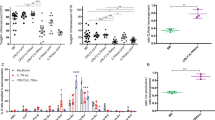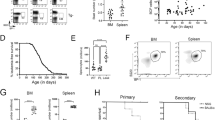Abstract
On the subject of acute myeloid leukemia (AML), there is little consensus about the target cell within the hematopoietic stem cell hierarchy that is susceptible to leukemic transformation, or about the mechanism that underlies the phenotypic, genotypic and clinical heterogeneity. Here we demonstrate that the cell capable of initiating human AML in non-obese diabetic mice with severe combined immunodeficiency disease (NOD/SCID mice) — termed the SCID leukemia-initiating cell, or SL-IC — possesses the differentiate and proliferative capacities and the potential for self-renewal expected of a leukemic stem cell. The SL-ICs from all subtypes of AML analyzed, regardless of the heterogeneity in maturation characteristics of the leukemic blasts, were exclusively CD34++ CD38−, similar to the cell-surface phenotype of normal SCID-repopulating cells, suggesting that normal primitive cells, rather than committed progenitor cells, are the target for leukemic transformation. The SL-ICs were able to differentiate in vivo into leukemic blasts, indicating that the leukemic clone is organized as a hierarchy.
This is a preview of subscription content, access via your institution
Access options
Subscribe to this journal
Receive 12 print issues and online access
$209.00 per year
only $17.42 per issue
Buy this article
- Purchase on SpringerLink
- Instant access to full article PDF
Prices may be subject to local taxes which are calculated during checkout
Similar content being viewed by others
References
Fialkow, P. et al. Clonal development, stem-cell differentiation, and clinical remission in acute nonlymphocytic leukemia. N. Engl. J. Med. 317, 468–473 (1987).
McCulloch, E. Stem cells in normal and leukemic hemopoiesis (Henry StrattonLecture). Blood 62, 1–13 (1983).
Griffin, J. & Löwenberg, B. Clonogenic cells in acute myeloblastic leukemia. Blood 68, 1185–1195 (1986).
Cline, M.J. The molecular basis of leukemia. N. Engl. J. Med. 330, 328–336 (1994).
Berger, R. et al. Cytogenetic studies on 519 consecutive de novo acute nonlympho cytic leukemias. Cancer Genet. Cytogenet. 29, 9–21 (1987).
Bennett, J. et al. Proposals for the classification of the acute leukemias. Br. J. Haematol. 33, 451–458 (1976).
Fialkow, P.J. et al. Acute nonlymphocytic leukemia: Heterogeneity of stem cell origin. Blood 57, 1068–1073 (1981).
Bartram, C.R. et al. Acute myeloid leukemia: Analysis of ras gene mutations and clonality defined by polymorphic X-linked loci. Leukemia 3, 247–256 (1989).
van Lorn, K., Hagemeijer, A., Smit, E.M. & Lowenberg, B. In situ hybridization on May-Grünwald Giemsa-stained bone marrow and blood smears of patients with hematologic disorders allows detection of cell-lineage-specific cytogenetic abnormalities. Blood 82, 884–888 (1993).
Fearon, E., Burke, P., Schiffer, C., Zehnbauer, B. & Vogelstein, B. Differentiation of leukemia cells to polymorphonuclear leukocytes in patients with acute nonlymphoblastic leukemia. N. Engl. J. Med. 315, 15–24 (1986).
Feuring-Buske, M. et al. Trisomy 4 in ‘stem cell-like’ leukemic cells of a patient with AML. Leukemia 9, 1318–1320 (1995).
Greaves, M.F. Stem cell origins of leukaemia and curability. Br. J. Cancer 67, 413–423 (1993).
Keinänen, M., Griffin, J., Bloomfield, C., Machnrcki, J. & de la Chapelle, A. Clonalchromosomal abnormalities showing multiple-cell-lineage involvement in acute myeloid leukemia. N. Engl.J. Med. 318, 1153–1158 (1988).
McCulloch, E.A. et al. Heterogeneity in acute myeloblastic leukemia. Leukemia 2, 38S–49S (1988).
Haase, D. et al. Evidence for malignant transformation in acute myeloid leukemia at the level of early hematopoietic stem cells by cytogenetic analysis of CD34+sub-populations. Blood 86, 2906–2912 (1995).
Mehrotra, B. et al. Cytogenetically aberrant cells in the stem cell compartment (CD34+1in−) in acute myeloid leukemia. Blood 86, 1139–1147 (1995).
Larochelle, A. et al. Identification of primitive hematopoietic cells capable of repopulating NOD/SCID mouse bone marrow: Implications for gene therapy. Nature Med. 2, 1329–1337 (1996).
Dick, J.E. Normal and leukemic stem cells assayed in SCID mice. Semin. Immunol. 8, 197–206 (1996).
Bhatia, M., Wang, J., Kapp, U., Bonnet, D. & Dick, J. Purification of primitive human hematopoietic cells capable of repopulating NOD/SCID mice. Proc. Natl.Acad. Sci.USA 94, 5320–5325 (1997).
Lapidot, T. et al. A cell initiating human acute myeloid leukaemia after transplantation into SCID mice. Nature 367, 645–648 (1994).
Larochelle, A. et al. Engraftment of immune-deficient mice with primitivehematopoietic cells from beta-thalassemia and sickle cell anemia patients:Implications for evaluating human gene therapy protocols. Hum. Mol. Genet. 4, 163–172 (1995).
Wang, J., Doedens, M. & Dick, J. Primitive human hematopoietic cells are enrichedin cord blood compared to adult bone marrow or mobilized peripheral blood as measured by the quantitative in vivo SCID-repopulating cell (SRC) assay. Blood 89, 3919–3924 (1997).
Porter, E. & Berry, R. The efficient design of transplantable tumor assays. Br. J. Cancer 17, 583–595 (1964).
Taswell, C. Limiting dilution assays for the determination of immunocompetent cell frequencies. I. Data analysis. J. Immunol. 126, 1614–1619 (1981).
Civin, C. et al. Antigenic analysis of hematopoiesis. III. A hematopoietic progenitor cell surface antigen defined by a monoclonal antibody raised against KG-1 a cells. J. Immunol. 133, 157–165 (1984).
Terstappen, L.W.W.M., Huang, S., Safford, M., Lansdorp, P.M. & Loken, M.R. Sequential generations of hematopoietic colonies derived from single nonlineagecommitted CD34+CD38 progenitor cells. Blood 77, 1218–1227 (1991).
Terstappen, L. et al. Flow cytometry characterization of acute myeloid leukemia: IV. Comparison to the differentiation pathway of normal hematopoietic cells. Leukemia 6, 993–1000 (1992).
Cashman, J. et al. Kinetic evidence of the regeneration of multilineage hematopoiesis from primitive cells in normal human bone marrow transplanted into immunodeficient mice. Stood (in the press).
Moore, M., Williams, N. & Metcalfe, D. In vitro colony formation by normal and leukemic human hematopoietic cells: Characterization of the colony-forming cells. J. Natl. Cancer Inst. 50, 603 (1974).
Sutherland, H., Blair, A. & Zapf, R.W. Characterization of a hierarchy in human acute myeloid leukemia progenitor cells. Blood 87, 4754–4761 (1996).
Craig, W., Kay, R., Cutler, R.B. & Lansdorp, P.M. Expression of Thy-1 on human hematopoietic progenitor cells. J. Exp. Med. 177, 1331–1342 (1993).
Terpstra, W. et al. Long-term leukemia-initiating capacity of a CD34− subpopulation of acute myeloid leukemia. Stood 87, 2187–2194 (1996).
Sawyers, C., Gishizky, M., Quan, S., Golde, D. & Witte, O. Propagation of human blastic myeloid leukemias in the SCID mouse. Blood 79, 2089–2098 (1992).
Cesano, A. et al. The severe combined immunodeficient (SCID) mouse as a model for myeloid leukemias. Oncogene 7, 827–836 (1992).
Turhan, A.G. et al. Highly purified primitive hematopoietic stem cells are PML-RARA negative and generate nonclonal progenitors in acute promyelocytic leukemia. Stood 85, 2154–2161 (1995).
Lapidot, T. et al. Cytokine stimulation of multilineage hematopoiesis from immature human cells engrafted in SCID mice. Science 255, 1137–1141 (1992).
Vormoor, J. et al. Immature human cord blood progenitors engraft and proliferate to high levels in immune-deficient SCID mice. Stood 83, 2489–2497 (1994).
Sirard, C. et al. Normal and leukemic SCID-repopulating cells (SRC) co-exist in the bone marrow and peripheral blood from CML patients in chronic phase while leukemic SRC are detected in blast crisis. Stood 87, 1539–1548 (1996).
Waye, J.S. & Willard, H.F. Structure, organization and sequence of alpha satellite DNA from human chromosome 17: Evidence for evolution by unequal crossing-over and ancestral pentamer repeat shared with the human X chromosome. Mol. Cell. Biol. 6, 3156–3165 (1986).
Author information
Authors and Affiliations
Rights and permissions
About this article
Cite this article
Bonnet, D., Dick, J. Human acute myeloid leukemia is organized as a hierarchy that originates from a primitive hematopoietic cell. Nat Med 3, 730–737 (1997). https://doi.org/10.1038/nm0797-730
Received:
Accepted:
Issue Date:
DOI: https://doi.org/10.1038/nm0797-730
This article is cited by
-
TMIGD2 is an orchestrator and therapeutic target on human acute myeloid leukemia stem cells
Nature Communications (2024)
-
Pituitary stem cells: past, present and future perspectives
Nature Reviews Endocrinology (2024)
-
Inhibition of mitochondrial folate metabolism drives differentiation through mTORC1 mediated purine sensing
Nature Communications (2024)
-
Label-free microfluidic chip for segregation and recovery of circulating leukemia cells: clinical applications in acute myeloid leukemia
Biomedical Microdevices (2024)
-
Comprehensive Review on the Effect of Stem Cells in Cancer Progression
Current Tissue Microenvironment Reports (2024)




